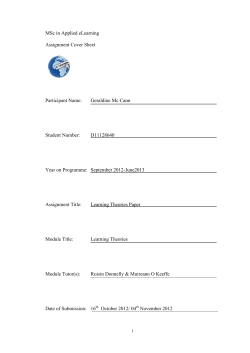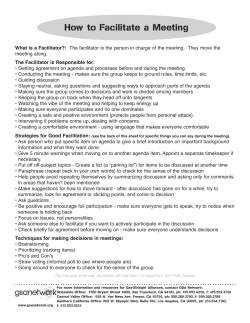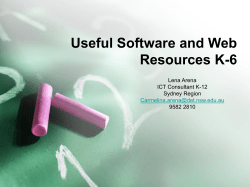
Management of a Training Program – 14, 2009 January 12
Management of a Training Program January 12 – 14, 2009 Learning Objectives • Understand the role of a training manager and a trainer of ICT users’ training activities. • Prepare a training management plan • Describe a method to develop a process of determining the: – background of would-be training participants; & – approach to the training. • Describe a method to select trainers for the training activities. Scope of Training Training Management Framework Training Plan, Design and Methods Monitoring and Evaluation Training Management Tools Scope and Schedule Day 1 • Introduction – Learning Objectives – Scope • What is a Training Program - Framework - Management Approach • Quality Planning: - Preparing for the Work Plan, Budget and Logistics Day 2 and 3 • Preparing for a Training Plan - The Stakeholders - The TNA • Training Methods - Use of Equipment and Technology • Monitoring and Evaluation • Summary and Conclusion Training Methodology • • • • Lecture and Discussions Case Examples Workshops Training Materials and Templates Framework Setting Management of a Training Program What is a Training Program? • A set of learning activities • Designed to meet the objectives of the learner and the organization. A Training Program Varied reasons for training - to introduce, develop, enhance - Knowledge, - Skills - Orientations/attitudes that are helpful to meet and advance the intentions of an organization. Why manage a training program A training program whether simple or complex needs to be: –Designed and Planned –Organized and Coordinated, –Monitored and Evaluated A training manager must be on top of the training program Managing a Training Program • Why train? • Who will attend the training? • What are the learning objectives? Strategies? Coverage? • How will the training program be implemented? • Who is/are the trainor/s? Managing a Training Program • What are the requirements to carry out the training program? What are the schedules, timeline, and budget of the training program? • What are the opportunities and risks of the program? Review: ICT for Development Training Program Hierarchy of Results • • • • Strategy and Purposes Goals and Objectives Inputs Activities Significant ICT/PM Problems Frequency A project office or a clearly defined project organization 42% Integrated Methods 41% Training and Mentoring 38% Policies and Procedures 35% Implementation Plans 23% Executive Support 22% Source: Computerworld, cited in Taylor, 2004 Lessons Learned in PM & ICTD • Participation • Local Ownership and Capacity Development • Mix of Technology • Multi Stakeholders Partnership • Alignment with Poverty Reduction Strategies Source: SDC 2007 Lessons Learned in PM & ICTD • • • • • Financial and Social Sustainability Risk Considerations Competitive Enabling Environment Institutional Ownership and Leadership Invest in Researches Source: SDC 2007 Training Program = Project Project - A set of principles, practices, techniques applied to 1lead project teams and 2control project schedule, cost, and risks to deliver the results of a successful project to the delighted stakeholders. What do you Manage scope time workplan integration quality deliverables risk issues cost procurement stakeholders communication PM/Training Focus Process People Optimum Performance Technology Project Management • Scope –covers all of the work required to complete the project successfully. Some of the tools and techniques include definition of the project need, identification of key stakeholders, identification of project drivers, development of operational concepts, and identification of external interfaces. (Mathur) • Time –refers to the duration of the project and the estimated time when tasks will be completed. Tools that help manage time include Gantt charts schedulers. • Cost –refers to the money allocated and the money that will be spent for project activities, tasks and services. Project managers need to manage costs well. • Integration –refers to coordination of project plans to create a consistent, coherent document. It also involves making tradeoffs among competing objectives and alternatives to meet or exceed stakeholder needs & expectation. (PMI cited in Wikipedia) Project Management • Quality –refers to standards, forms, user focus and reliability of planned project performance. • Human Resource –refers to the people (individuals, teams, contracted professionals) who will be involved in the project. • Communication – refers to the messages that need to be put across to manage change & expectations. • Risk –the collective term for uncertainties that pose threats, limitations and obstacles to the achievement of project goals and objectives. Risks could be internal or external. The manager needs to ensure that risks are minimized, mitigated or leveraged to benefit the project process. • Procurement – This refers to the process of acquiring goods and services, infrastructure and equipment that are needed by the project to meet its goals, objectives & deliverables. What are the PM Phases Project Cycle Management Systems Life Cycle PM Phases Project Life Cycle Systems Development Life Cycle CON CEPT REQUIRE MENTS DESIGN IMPLE MENTA TION INTEGRA TION & TEST SYSTEMS INSTALLA TION MAINTE NANCE & SUPPORT Source: Taylor, 2004 PM Good Practices • Defining what has to be accomplished in relation to time, cost, technical and quality performance parameters; • Developing a plan, implementing the plan and ensuring that progress is maintained in line with objectives; • Using appropriate project management techniques and tools to plan, monitor and maintain progress; • Employing appropriate and skilled persons accountable for its successful accomplishment. • Ensuring the alignment of development goals and priorities with the goals of the development project with stakeholders. PM Good Practices • Communications and Communications Planning, designing a plan how to communicate effectively with stakeholders • Project Tracking, continuously and consistently checking the status of scope, schedule and costs • Managing Changes, deciding whether or not to accept, or reject or to integrate the changes right away • Managing Risks, identifying events that could adversely affect the project as early as possible and incorporate action plans necessary to avoid or mitigate these risks. Source: Simon Buering, http://www.computerworlduk.com Quality Planning Management of a Training Program Planning • Essential Processes/Disciplines – Training Plan: Details – Milestone: Approved Training Plan • Tools – Work Breakdown Structure (WBS) – Gantt Chart – Cost Analysis • Sample Tool/Template: WBS Training WBS Sample.odt Planning the Work, Resources and Costs Work Breakdown Number of Days to Do the Work Who will do the work Other Resources Needed Cost of the work to be done Outputs Work Breakdown Structure Source: Taylor, 2004 Sample Work Breakdown Sample Gantt Chart Training Cost • Cost Analysis – Direct Costs • • • • Administrative and Management Costs Services/Instruction – Instructors/Facilitators Instructional Materials Training Equipment – Indirect Costs • Services • Utilities and Facilities • Participants’ Costs • Others Sample Training Cost Budget and Summary.docx Preparing for a Training Program Management of a Training Program The Training Task Goal Input Learner’s Role TASK Facilitator’s Role Activities Settings Intercultural Approach Nunan, 1989: 10 – 11 cited in Corbett, 2003 Training Task • Goal – the pedagogical purpose of the task • Input – the stimulus provided by the facilitator for learning to occur • Activities – full range of communicative activities to serve goals • Learner’s role – vary and progresses from activity to activity, stage to stage • Facilitator’s role – mirror image of the learner • Settings – the mode of learning (e.g. individual or group work)
© Copyright 2025





















